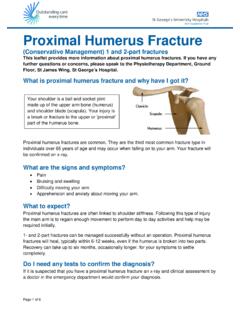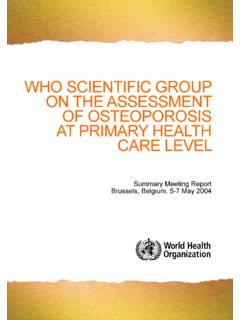Transcription of RIB FRACTURE MANAGEMENT GUIDELINE
1 Parent Policy: InsertLinkToParentPolicy Title: Rib FRACTURE GUIDELINE Standard Operating Procedure Effective Date: 07/20/2021 Prepared by: MGR, TRAUMA PROGRAM Approved by: MEDICAL DIR TRAUMA - RALEIGH No: 9598 Printed copies are for reference only. Please refer to the electronic copy for the latest version. RIB FRACTURE MANAGEMENT GUIDELINE Parent Policy: InsertLinkToParentPolicy Title: Rib FRACTURE GUIDELINE Standard Operating Procedure Effective Date: 07/20/2021 Prepared by: MGR, TRAUMA PROGRAM Approved by: MEDICAL DIR TRAUMA - RALEIGH No: 9598 Printed copies are for reference only. Please refer to the electronic copy for the latest version. RADIOLOGIC EVALUATION Definitions: 1. Location anterior, lateral, posterior a. Anterior = serratus anterior insertion tubercle to the distal end of the rib b. Lateral = costal angle to the serratus anterior insertion tubercle c. Posterior = the head and neck of the rib to the costal angle 2.
2 Displacement non-displaced, partially displaced, fully displaced a. Non-displaced = No displacement b. Partially displaced = Some cortical overlap, but not complete c. Fully displaced = No cortical overlap 3. FRACTURE pattern simple, wedge, comminuted a. Simple = single FRACTURE line b. Wedge = a second FRACTURE line that does not span the entire width of the rib c. Comminuted = multiple fractures with > 2 bone fragments 4. Radiologic flail chest = 3 or more consecutive ribs with 2 or more fractures in each rib ASSESSING SEVERITY OF INJURY It s important to note that numerous rib FRACTURE scoring systems exist. Some are based on clinical features of the injury, others entirely on cross-sectional imaging, and some use both clinical and radiologic features. Unfortunately, none are widely used or well validated. Furthermore, no scoring system is able to adequately take into account the heterogeneity of patient presentation and response to injury.
3 As such, assessing severity of injury requires clinical judgment. The following high-risk features help assess the severity of injury and determine what level of care and treatment the patient needs. 1. Age: >55 or frailty score >4 2. Incentive spirometry: <50% of expected inspiratory capacity (to be performed and documented in the ED, based on ideal body weight, see tables below) 3. Oxygenation: Requires supplemental O2 to maintain SpO2 >92% 4. Pain (subjective): severe (rated 7-10) 5. Pulmonary contusions (subjective): moderate or severe 6. FRACTURE pattern: a. Clinical flail chest (automatic ICU admission) b. >4 fractures c. >2 partially or fully displaced rib fractures d. Bilateral fractures If none of these high-risk features are present, consider discharge or floor admission If one or more of these high-risk features are present, consider step-down or ICU admission If two or more of these high-risk features are present, consider ICU admission Parent Policy: InsertLinkToParentPolicy Title: Rib FRACTURE GUIDELINE Standard Operating Procedure Effective Date: 07/20/2021 Prepared by: MGR, TRAUMA PROGRAM Approved by: MEDICAL DIR TRAUMA - RALEIGH No: 9598 Printed copies are for reference only.
4 Please refer to the electronic copy for the latest version. NON-SURGICAL MANAGEMENT Use order set Rib Fractures to access the following treatment options (also available via admission order sets). 1. Pain control: Per Multimodal Pain Control order set. 2. Pulmonary support o Incentive spirometry: Perform 10 times per hour while awake. 3. Non-invasive ventilation (NIV): o NIV helps maintain lung volumes and splints the chest wall. o Consider using in patients who are hypoxic despite optimal support and/or those with <50% of expected inspiratory capacity (based on predicted body weight, see tables below). o Orders: Initial: BiPAP, 10/5 cm H2O, 4 hrs on/off (8 AM - 8 PM) & continuous (12 AM - 8 AM), RT to titrate to goal tidal volume of 6-8 cc/kg predicted body weight and SpO2 > 92% Wean: When oxygenation improved and maximum inspiratory capacity >50% predicted, transition to BiPAP QHS only (continuously from 12am-8am) before transitioning off BiPAP altogether o Contraindications to NIV: Need for emergent intubation ( cardiac or respiratory distress), hemodynamic instability, altered mental status, inability to protect the airway, facial fractures, insufficient staffing/monitoring abilities 4.
5 Repeat chest x-ray o Obtain a morning chest x-ray on post-injury day #1 an as needed thereafter o Use the x-ray to assess for progression of pneumothorax and/or hemothorax and dynamic chest wall changes. o For retained hemothorax, refer to Retained Hemothorax GUIDELINE 5. Out of bed o Patient should be out of bed to chair and/or walking as able 6. Patient education o The following Healthwise documents are added to the nursing education queue when a diagnosis of rib fractures is entered into EPIC: rib FRACTURE , incentive spirometer, how to use an incentive spirometer video, and acute pain MANAGEMENT . o You can also add Healthwise information to the patient s discharge document in EPIC: Discharge Manager Clinical References Go to references/Attachments Additional search SURGICAL MANAGEMENT Indications for rib plating are patient specific. Patients with one or more of these features should be considered for rib plating: Impending or actual respiratory failure or failure to wean from mechanical ventilation due to rib FRACTURE pain refractory to other treatment strategies (not related to pulmonary contusions).
6 Significant chest wall deformity or instability, including flail chest >2 partially or fully displaced rib fractures Nonunion or malunion * If feasible, rib plating should be performed <72 hours after injury Parent Policy: InsertLinkToParentPolicy Title: Rib FRACTURE GUIDELINE Standard Operating Procedure Effective Date: 07/20/2021 Prepared by: MGR, TRAUMA PROGRAM Approved by: MEDICAL DIR TRAUMA - RALEIGH No: 9598 Printed copies are for reference only. Please refer to the electronic copy for the latest version. Parent Policy: InsertLinkToParentPolicy Title: Rib FRACTURE GUIDELINE Standard Operating Procedure Effective Date: 07/20/2021 Prepared by: MGR, TRAUMA PROGRAM Approved by: MEDICAL DIR TRAUMA - RALEIGH No: 9598 Printed copies are for reference only. Please refer to the electronic copy for the latest version. References 1. Ziegler DW, Agarwal NN. The morbidity and mortality of rib fractures.
7 J Trauma. 1994 Dec;37(6):975-9. 2. Brasel KJ, Guse CE, Layde P, Weigelt JA. Rib fractures: relationship with pneumonia and mortality. Crit Care Med. 2006 Jun;34(6):1642-6. 3. Bulger EM, Arneson MA, Mock CN, Jurkovich GJ. Rib fractures in the elderly. J Trauma. 2000 Jun;48(6):1040-6; discussion 1046-7. 4. Davignon K, Kwo J, Bigatello LM. Pathophysiology and MANAGEMENT of the flail chest. Minerva Anestesiol. 2004 Apr;70(4):193-9. 5. Dehghan N, de Mestral C, McKee MD, Schemitsch EH, Nathens A. Flail chest injuries: a review of outcomes and treatment practices from the National Trauma Data Bank. J Trauma Acute Care Surg. 2014 Feb;76(2):462-8. 6. Flagel BT, Luchette FA, Reed RL, Esposito TJ, Davis KA, Santaniello JM, Gamelli RL. Half-a-dozen ribs: the breakpoint for mortality. Surgery. 2005 Oct;138(4):717-23; discussion 723-5. 7. Brasel KJ, Moore EE, Albrecht RA, deMoya M, Schreiber M, Karmy-Jones R, Rowell S, Namias N, Cohen M, Shatz DV, Biffl WL.
8 Western Trauma Association Critical Decisions in Trauma: MANAGEMENT of rib fractures. J Trauma Acute Care Surg. 2017 Jan;82(1):200-203. 8. Yang Y, Young JB, Schermer CR, Utter GH. Use of ketorolac is associated with decreased pneumonia following rib fractures. Am J Surg. 2014 Apr;207(4):566-72. 9. Kasotakis G, Hasenboehler EA, Streib EW, Patel N, Patel MB, Alarcon L, Bosarge PL, Love J, Haut ER, Como JJ. Operative fixation of rib fractures after blunt trauma: A practice MANAGEMENT GUIDELINE from the Eastern Association for the Surgery of Trauma. J Trauma Acute Care Surg. 2017 Mar;82(3):618-626. 10. Galvagno SM Jr, Smith CE, Varon AJ, Hasenboehler EA, Sultan S, Shaefer G, To KB, Fox AD, Alley DE, Ditillo M, Joseph BA, Robinson BR, Haut ER. Pain MANAGEMENT for blunt thoracic trauma: A joint practice MANAGEMENT GUIDELINE from the Eastern Association for the Surgery of Trauma and Trauma Anesthesiology Society. J Trauma Acute Care Surg.
9 2016 Nov;81(5):936-951. 11. Carver TW, Milia DJ, Somberg C, Brasel K, Paul J. Vital capacity helps predict pulmonary complications after rib fractures. J Trauma Acute Care Surg. 2015 Sep;79(3):413-6. 12. Simon B, Ebert J, Bokhari F, Capella J, Emhoff T, Hayward T 3rd, Rodriguez A, Smith L; Eastern Association for the Surgery of Trauma. MANAGEMENT of pulmonary contusion and flail chest: an Eastern Association for the Surgery of Trauma practice MANAGEMENT GUIDELINE . J Trauma Acute Care Surg. 2012 Nov;73(5 Suppl 4):S351-61. 13. Majercik S, Cannon Q, Granger SR, VanBoerum DH, White TW. Long-term patient outcomes after surgical stabilization of rib fractures. Am J Surg. 2014 Jul;208(1):88-92. 14. Bhatnagar A, Mayberry J, Nirula R. Rib FRACTURE fixation for flail chest: what is the benefit? J Am Coll Surg. 2012 Aug;215(2):201-5. 15. Pieracci FM, Lin Y, Rodil M, Synder M, Herbert B, Tran DK, Stoval RT, Johnson JL, Biffl WL, Barnett CC, Cothren-Burlew C, Fox C, Jurkovich GJ, Moore EE.
10 A prospective, controlled clinical evaluation of surgical stabilization of severe rib fractures. J Trauma Acute Care Surg. 2016 Feb;80(2):187-94. Parent Policy: InsertLinkToParentPolicy Title: Rib FRACTURE GUIDELINE Standard Operating Procedure Effective Date: 07/20/2021 Prepared by: MGR, TRAUMA PROGRAM Approved by: MEDICAL DIR TRAUMA - RALEIGH No: 9598 Printed copies are for reference only. Please refer to the electronic copy for the latest version.









